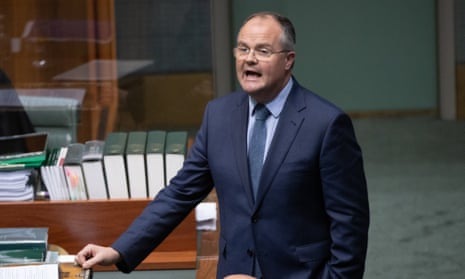The shadow energy minister and long-time nuclear advocate Ted O’Brien has accused Labor of weaponising a CSIRO report which found renewables to be the cheapest form of energy.
The Australian Energy Market Operator/CSIRO report found renewables was the cheapest form of power. This prompted the climate change minister, Chris Bowen, to say the opposition’s crusade for a nuclear option was not viable.
O’Brien has long championed nuclear as a solution to Australia’s emissions reduction energy transition, despite the prohibitive costs and the Coalition government he belonged to showing no serious appetite to embrace nuclear while in power.
In response to the latest report, O’Brien said it examined costs through an investment lens, rather than a consumer lens.
Investment costs are passed on to consumers in order for investors to recoup and profit from their investment. The report deliberately examines technology costs, which is one of the main drivers of energy investment, to help guide both government and private investors spending in the Australian energy market.
“If an energy plan is to reduce household energy prices it must put consumers at the centre, not investors,” O’Brien said.
“But Labor ignores this distinction and instead weaponises GenCost by deliberately misrepresenting the report and assuring Australians its ‘renewables only’ policy is reducing power prices.
“Labor points to GenCost to argue that renewables are the cheapest form of energy, but they fail to finish the sentence – renewables may be the cheapest form of energy for investors, but not for consumers.”
Bowen said the report, which is used to help give guidance to both government and investors about the cheapest forms of energy, vindicated Labor’s energy transition policies.
“The draft report today makes it crystal‑clear, the cheapest form of energy is renewable energy,” he said.
“Renewable energy is cheaper than coal, cheaper than gas, much, much, much cheaper than nuclear energy. Nuclear energy is the most expensive form of energy available.”
The report authors looked to the one feasible nuclear small reactor project in the world, the Carbon Free Power Project in the US, to draw it’s cost and timing conclusions.
The company had projected costs of A$18,200/kW in 2020 which jumped to A$31,100/kW in 2022 as a result of global inflation. With cheaper energy options, CFPP had trouble securing energy provision contracts and the project was cancelled in November this year. The project had previously been hailed by O’Brien as evidence of a “burgeoning” global nuclear industry.
By comparison, the GenCost report found that under existing policies, the cost of a new offshore windfarm would be between $5,545/kW to $6,856/kW (fixed to floating) while rooftop solar in 2023 cost $1,505/kW.
Bowen said the opposition needed to question whether it would continue “with their ideological fact‑free attraction to nuclear energy”.
after newsletter promotion
“Nuclear energy is a fantasy wrapped up in a pipe dream for Australia,” he said.
“It also is not available by 2030, so if the opposition thinks it’s going to play a role in Australia in meeting 2030 targets, they are engaging in a fantasy.”
The report found that if Australia did decide to make a nuclear small modular reactor as part of its energy mix, it would take until at least 2038 to be fully operational in a best-case scenario based on the deployment timing of the cancelled US project.
It also found that renewable energy would probably be at least three times cheaper than nuclear energy by that date.
O’Brien argued the government should adopt “an all of the above approach to technology” and that the Coalition would continue to push for a serious exploration of nuclear.
Technology cost for renewables is expected to continue to decrease over the next six years to 2030, although it found that almost all energy technology capital costs increased over the last year due to inflation.
Capital costs for onshore windfarms and solar farms both increased by 8%, batteries increased by 2% and gas turbines increased by 14%.
Fossil fuels were more complicated, given their reliance on long-term energy provision contracts and growing investor reluctance because of climate policy risks.
The report will remain open for consultation for six weeks.
